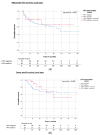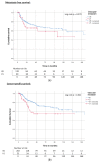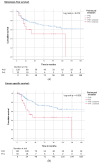Evaluation of Prognostic Parameters to Identify Aggressive Penile Carcinomas
- PMID: 37835442
- PMCID: PMC10571727
- DOI: 10.3390/cancers15194748
Evaluation of Prognostic Parameters to Identify Aggressive Penile Carcinomas
Abstract
Background: Advanced penile carcinoma is characterized by poor prognosis. Most data on prognostic factors are based on small study cohorts, and even meta-analyses are limited in patient numbers. Therefore, there is still a lack of evidence for clinical decisions. In addition, the most recent TNM classification is questionable; in line with previous studies, we found that it has not improved prognosis estimation.
Methods: We evaluated 297 patients from Germany, Russia, and Portugal. Tissue samples from 233 patients were re-analyzed by two experienced pathologists. HPV status, p16, and histopathological parameters were evaluated for all patients.
Results: Advanced lymph node metastases (N2, N3) were highly significantly associated with reductions in metastasis-free (MFS), cancer-specific (CS), and overall survival (OS) rates (p = <0.001), while lymphovascular invasion was a significant parameter for reduced CS and OS (p = 0.005; p = 0.007). Concerning the primary tumor stage, a significant difference in MFS was found only between pT1b and pT1a (p = 0.017), whereas CS and OS did not significantly differ between T categories. In patients without lymph node metastasis at the time of primary diagnosis, lymphovascular invasion was a significant prognostic parameter for lower MFS (p = 0.032). Histological subtypes differed in prognosis, with the worst outcome in basaloid carcinomas, but without statistical significance. HPV status was not associated with prognosis, either in the total cohort or in the usual type alone.
Conclusion: Lymphatic involvement has the highest impact on prognosis in penile cancer, whereas HPV status alone is not suitable as a prognostic parameter. The pT1b stage, which includes grading, as well as lymphovascular and perineural invasion in the T stage, seems questionable; a revision of the TNM classification is therefore required.
Keywords: HPV; histological subtype; p16; penile cancer; prognosis.
Conflict of interest statement
The authors declare no conflict of interest.
Figures





















References
LinkOut - more resources
Full Text Sources

